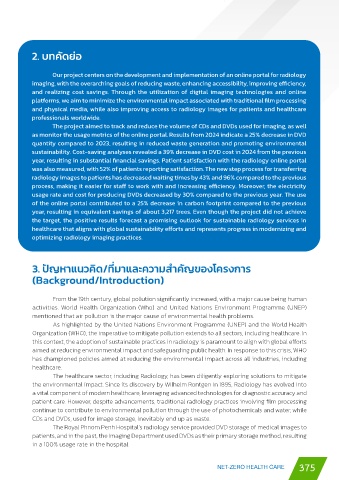Page 375 - BDMS AWARDS 2024
P. 375
2. บทคััดยุ่อ
Our project centers on the development and implementation of an online portal for radiology
imaging, with the overarching goals of reducing waste, enhancing accessibility, improving efficiency,
and realizing cost savings. Through the utilization of digital imaging technologies and online
platforms, we aim to minimize the environmental impact associated with traditional film processing
and physical media, while also improving access to radiology images for patients and healthcare
professionals worldwide.
The project aimed to track and reduce the volume of CDs and DVDs used for imaging, as well
as monitor the usage metrics of the online portal. Results from 2024 indicate a 25% decrease in DVD
quantity compared to 2023, resulting in reduced waste generation and promoting environmental
sustainability. Cost-saving analyses revealed a 39% decrease in DVD cost in 2024 from the previous
year, resulting in substantial financial savings. Patient satisfaction with the radiology online portal
was also measured, with 52% of patients reporting satisfaction. The new step process for transferring
radiology images to patients has decreased waiting times by 43% and 96% compared to the previous
process, making it easier for staff to work with and increasing efficiency. Moreover, the electricity
usage rate and cost for producing DVDs decreased by 30% compared to the previous year. The use
of the online portal contributed to a 25% decrease in carbon footprint compared to the previous
year, resulting in equivalent savings of about 3,217 trees. Even though the project did not achieve
the target, the positive results forecast a promising outlook for sustainable radiology services in
healthcare that aligns with global sustainability efforts and represents progress in modernizing and
optimizing radiology imaging practices.
3. ปัญหาแนวัคัิด/ที�มาแลัะคัวัามส่ำาคััญของโคัรงการ
(Background/Introduction)
From the 19th century, global pollution significantly increased, with a major cause being human
activities. World Health Organization (Who) and United Nations Environment Programme (UNEP)
mentioned that air pollution is the major cause of environmental health problems.
As highlighted by the United Nations Environment Programme (UNEP) and the World Health
Organization (WHO), the imperative to mitigate pollution extends to all sectors, including healthcare. In
this context, the adoption of sustainable practices in radiology is paramount to align with global efforts
aimed at reducing environmental impact and safeguarding public health. In response to this crisis, WHO
has championed policies aimed at reducing the environmental impact across all industries, including
healthcare.
The healthcare sector, including Radiology, has been diligently exploring solutions to mitigate
the environmental impact. Since its discovery by Wilhelm Rontgen in 1895, Radiology has evolved into
a vital component of modern healthcare, leveraging advanced technologies for diagnostic accuracy and
patient care. However, despite advancements, traditional radiology practices involving film processing
continue to contribute to environmental pollution through the use of photochemicals and water, while
CDs and DVDs, used for image storage, inevitably end up as waste.
The Royal Phnom Penh Hospital’s radiology service provided DVD storage of medical images to
patients, and in the past, the Imaging Department used DVDs as their primary storage method, resulting
in a 100% usage rate in the hospital.
375
NET-ZERO HEALTH CARE

